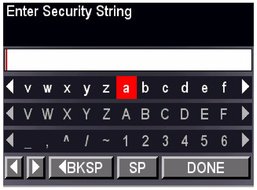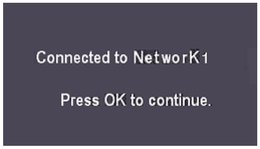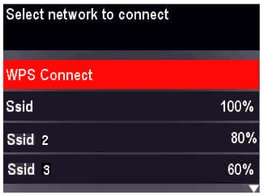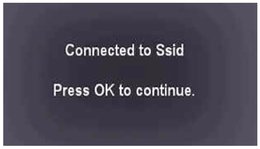KODAK ESP Office 2100 Series All-in-One Printers — Extended User Guide
Table of Contents > Networking Your Printer > Connecting to a wireless network
2 Networking Your Printer
Connecting to a wireless network
To connect your printer to an 802.11b/g/n wireless (Wi-Fi) network, refer to the following information.
Before you connect
You need:
-
a wireless router.
-
to determine whether your wireless router supports Wi-Fi Protected Setup (WPS).
NOTE: If you have specific questions about your router, see your router manufacturer's documentation for more information.
Connecting to a wireless network using the Wi-Fi Setup Wizard
You can use the Wi-Fi Setup Wizard on the printer to connect to your wireless network. Use the procedures that is appropriate for your network setup.
Connecting to a non-WPS wireless router
To connect your printer to your wireless network, you need to know the network name, also called the Service Set Identifier (SSID). You can obtain your network name from the wireless router. See the manufacturer's documentation for more information.
If you have enabled security on your network, you also need to know the security string (passphrase or password), which may be a Wired Equivalent Privacy (WEP) or a Wi-Fi Protected Access (WPA/WPA2) passphrase.
Record your network information using the correct uppercase and lowercase letters.
Network Name (SSID):
Security String (case-sensitive):
-
Press Home.
-
Press
 to select Network Settings, then press OK.
to select Network Settings, then press OK. -
With Wi-Fi Setup Wizard selected, press OK.
NOTE: The Wi-Fi radio turns on when you select Wi-Fi Setup Wizard.
The Wi-Fi connectivity LED blinks as the printer searches for available wireless networks within range, then displays the list in order of signal strength. For example:

If there are additional networks than can be shown on the LCD, press
 to view them.
to view them. -
Press
 to select your network, then press OK.
to select your network, then press OK. If you don't see your network in the list, or if you want to change your network, select Rescan for Wireless Networks, then press OK.
NOTE: If the name of your network is not listed, make sure your wireless router is turned on and within range.
-
If your network requires a password, use the LCD keyboard to enter your Security String. The Security String is case-sensitive.

On the control panel, press
 ,
,  ,
,  or
or  to select the letters and numbers. When you are finished, select DONE, then press OK
to select the letters and numbers. When you are finished, select DONE, then press OK
-
When the confirmation message appears, press OK.

When the printer is successfully connected, the Wi-Fi connectivity LED will stop blinking and remains lit.
The printer with a wireless connection is listed as the name of the printer plus a number (for example, KodakESPOffice2150+0034).
-
If you haven't yet installed the KODAK All-in-One Printer Software, insert the CD that came with the printer into the computer CD drive, and follow the on-screen instructions. When the software checks for updates, if a newer version exists, install the newer version. (On a computer with MAC OS, be sure to select the option to check for newer versions.)
NOTE: If you do not have the CD:
-
In the results list, click the link for KODAK All-in-One Printer Software for your computer's operating system.
-
Follow the on-screen instructions.
Connecting to a WPS wireless router
If your router supports Wi-Fi Protected Setup (WPS), use WPS Connect. WPS lets you configure your printer for a wireless network by pressing buttons or entering a PIN.
To connect to a network using WPS:
-
Press Home.
-
Press
 to select Network Settings, then press OK.
to select Network Settings, then press OK. -
With Wi-Fi Setup Wizard selected, press OK.
NOTE: The Wi-Fi radio turns on automatically when you select Wi-Fi Setup Wizard.
-
With WPS Connect selected, press OK.

-
Select one of two methods of connecting:
IMPORTANT: Before you press OK on the printer, make sure you know where the router's push button is, or where to enter the generated PIN. If necessary, consult your Internet Service Provider or router device manufacturer's documentation for more information.
Using Push Button Configuration Entering WPS PIN NOTE: You will have two minutes to press or select the WPS button. It may be a button on the device or a virtual button in the device's software.
-
With Push Button Configuration selected, press OK.
-
Press or select the WPS button for your wireless router.
-
Press
 to select Generate WPS PIN, then press OK.
to select Generate WPS PIN, then press OK. -
In your wireless router's software, locate the PIN screen, then follow the router's instructions.
-
Enter the PIN you received on the LCD into the PIN screen.
-
-
When the confirmation message appears, press OK.

When the printer is successfully connected, the Wi-Fi connectivity LED stops blinking and remains lit.
The printer with a wireless connection is listed as the name of the printer plus a number (for example, KodakESPOffice2150+0034).
-
If you haven't yet installed the KODAK All-in-One Printer Software, insert the CD that came with the printer into the computer CD drive, and follow the on-screen instructions. When the software checks for updates, if a newer version exists, install the newer version. (On a computer with MAC OS, be sure to select the option to check for newer versions.)
NOTE: If you do not have the CD:
-
In the results list, click the link for KODAK All-in-One Printer Software for your computer's operating system.
-
Follow the on-screen instructions.
Setting up an IP Address
| IMPORTANT: | You should only need to set up an IP Address for your printer if you are having a problem connecting your printer to a wireless network. Typically, it is not necessary to set up an IP Address. This procedure is for advanced users. |
All IP Address entries have the following format: 000.000.000.000. If an address or Subnet Mask has only one or two characters between the periods, include one or two leading zeros in front of that number. For example:
|
The address as it may appear in your documentation |
How to enter the address in the printer menu |
|
149.89.138.149 |
149.089.138.149 |
|
149.2.40.149 |
149.002.040.149 |
To set up your IP Address on the printer:
-
Press Home.
-
Press
 to select Network Settings, then press OK.
to select Network Settings, then press OK. -
Press
 to select Advanced IP Address Setup, then press OK.
to select Advanced IP Address Setup, then press OK. -
Press OK again to continue.
-
Select one of the following, then press OK:
-
Dynamic (DHCP)
-
Manual (Static)
-
-
If you selected Manual (Static), you are prompted to enter an IP Address, a Subnet Mask, a Gateway Address, and a DNS Server address. Press OK after each entry. Use the navigation buttons to enter each digit of the numbers.
Consult your Internet Service Provider or network administrator for more information.
Viewing the network configuration
To view the network configuration and verify that you are connected to your wireless network:
-
Press Home.
-
Press
 to select Network Settings, then press OK.
to select Network Settings, then press OK. -
Press
 to select View Network Configuration, then press OK.
to select View Network Configuration, then press OK. The wireless network settings appear on the LCD, including:
-
Printer Name
-
Connection
-
Speed
-
IP Address Type
-
Connected Network SSID
-
Security
-
Authentication
-
Channel
-
Region
-
Radio (on/off)
If the printer is connected to your network, you will see the network name and the word CONNECTED.
-
-
To scroll through the information, press
 .
. -
When you are done, press OK.
Printing the network configuration
To print the current network configuration:
-
Load plain paper into the printer. (See Loading plain paper.)
-
Press Home.
-
Press
 to select Network Settings, then press OK.
to select Network Settings, then press OK. -
Press
 to select Print Network Configuration, then press OK.
to select Print Network Configuration, then press OK.
Installing your printer on additional computers on the network
To add your printer to another computer(s) on your network, install the KODAK All-in-One Printer Software on each computer.
-
Insert the CD that came with the printer into the computer CD drive, and follow the on-screen instructions. When the software checks for updates, if a newer version exists, install the newer version. (On a computer with MAC OS, be sure to select the option to check for newer versions.)
NOTE: If you do not have the CD:
-
In the results list, click the link for KODAK All-in-One Printer Software for your computer's operating system.
-
Follow the on-screen instructions.
Connecting to another KODAK All-in-One Printer
If you are connecting to a newer model printer (for example, you have an ESP 7 printer and now you are adding an ESP Office 2150 printer), you must install the KODAK All-in-One Printer Software for the newer model.
| NOTE: | When you install the new software, the printer driver for the ESP 7 printer will be uninstalled, and an upgraded driver for the ESP 7 printer will be installed in addition to the driver for the ESP Office 2150 printer. |
On a computer with WINDOWS OS:
-
Select Start > All Programs > Kodak > KODAK Printer Setup Utility.
-
If your wireless printer (example: KodakESPOffice2150+0034) is not listed:
-
Select No, my printer is not listed, then click Next.
-
From the drop-down list, select your printer.
-
Select Network - Wireless/Wi-Fi, then click Next. When your printer is detected, driver installation begins.
-
-
If your wireless all-in-one printer (example: KodakESPOffice2150+0034) is listed:
-
Select the all-in-one printer that is connected to your network.
-
Select Yes, my printer is listed, then click Next. When your printer is detected, driver installation begins.
-
-
-
When driver installation is complete, click Done.
-
Select Apple > System Preferences.
-
Under Hardware, select Print & Fax or Print & Scan.
-
Click + in the dialog box.
-
Select your printer from the list.
Previous Next